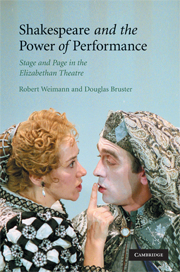Book contents
- Frontmatter
- Contents
- Acknowledgments
- Introduction
- Chapter 1 “Moralize two meanings” in one play: contrariety on the Tudor stage
- Chapter 2 Performance, game, and representation in Richard III
- Chapter 3 Mingling vice and “worthiness” in King John
- Chapter 4 Clowning: agencies between voice and pen
- Chapter 5 Clowning at the frontiers of representation
- Chapter 6 Cross-dressing and performance in disguise
- Chapter 7 Personation and playing: “secretly open” role-playing
- Chapter 8 Character/actor: the deep matrix
- Chapter 9 Character: depth, dialogue, page
- Chapter 10 King Lear: representations on stage and page
- Notes
- Index
- References
Chapter 10 - King Lear: representations on stage and page
Published online by Cambridge University Press: 22 September 2009
- Frontmatter
- Contents
- Acknowledgments
- Introduction
- Chapter 1 “Moralize two meanings” in one play: contrariety on the Tudor stage
- Chapter 2 Performance, game, and representation in Richard III
- Chapter 3 Mingling vice and “worthiness” in King John
- Chapter 4 Clowning: agencies between voice and pen
- Chapter 5 Clowning at the frontiers of representation
- Chapter 6 Cross-dressing and performance in disguise
- Chapter 7 Personation and playing: “secretly open” role-playing
- Chapter 8 Character/actor: the deep matrix
- Chapter 9 Character: depth, dialogue, page
- Chapter 10 King Lear: representations on stage and page
- Notes
- Index
- References
Summary
King Lear sets into motion before us a dynamic compendium of modes of playing in the early modern theatre. These modes range from Lear's madness, Edgar's excessive role-playing, Kent's threadbare disguise, and the “all-licensed Fool” to the lower, more earthy “new pranks” (Goneril's phrases [King Lear, 1.4.201, 238]) that recur so frequently in the tragedy. To an unsurpassed, even staggering extent, a thick performative mingles, but only partially coalesces, with a representation of Albion's division. Between them, and over a residual gap, the play is saturated with insights as unsanctioned as its wild assemblage of performance tricks and practices. The rendering of characters alone includes a full, bewildering assortment of acting styles and affects of the personal, from allegorical figuration and iconographic portraiture to the improvised personation and “deep” characterization we have examined in the preceding chapters. Far from narrowing the cultural scope that certain historicist readings have discerned in it, King Lear's astonishing array of dramaturgies enhances that scope. When “the realm of Albion” is “Come to great confusion” (3.2.85–6), for instance, it is the body-centered, diversionary practices of the mad Lear, the lawless Edgar, the proverbial fool, which seek to set it right. In its turn, the topsy-turvy thrust in bodies and discourses is itself subjected to a kind of reversal: “contrariety” is used to heal and to reveal, to turn a false order of things crossways, upside-down or inside-out.
- Type
- Chapter
- Information
- Shakespeare and the Power of PerformanceStage and Page in the Elizabethan Theatre, pp. 199 - 223Publisher: Cambridge University PressPrint publication year: 2008



